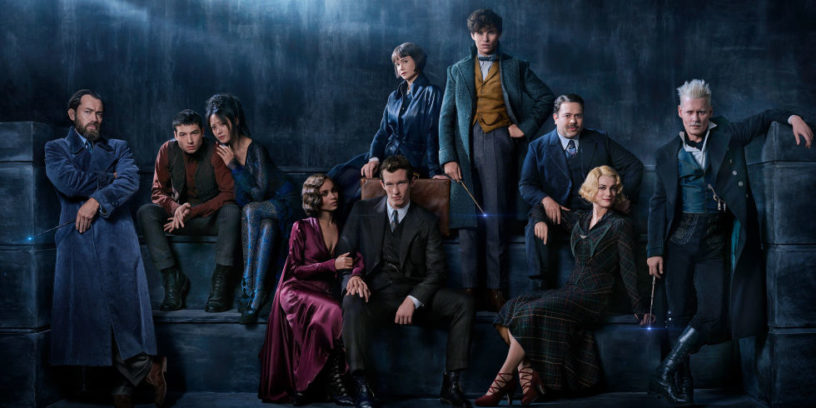The Wizarding World has returned for more magic.
Fantastic Beasts: The Crimes of Grindlewald follows the adventures of Newt Scamander (Eddie Redmayne) in Europe following his trip to America in 2016’s Fantastic Beasts and Where to Find Them.
The second of five planned films, Crimes takes place several months after the first film and details Gellert Grindlewald’s (Johnny Depp) escape from custody of the Magical Congress of the United States of America (MACUSA) and his efforts to recruit witches and wizards to his cause.
And for the first time in seven years, viewers get to see Albus Dumbledore (Jude Law) on the big screen. Dumbledore is in his youth in this film, which takes place in 1927.
In addition, we learn about Jacob (Dan Fogler) and Queenie (Alison Sudol) reuniting and Jacob getting his memories of the previous film back. Queenie even humorously charms Jacob to get him to marry her, despite the law in America preventing No-Majs and Witches and Wizards from even being friends. Meanwhile, Newt’s love interest Tina (Katherine Waterston) has returned to the Auror office and is searching for Credence in Paris.
The film, while overall enjoyable, spends a little too much of its time setting up the sequels. It raises several questions, but doesn’t spend enough time at least starting to answer them. One question in particular: Nagini (Claudia Kim) is said to be a Maledictus, which means that she has a blood curse that will transform her into a beast permanently. Obviously, we know from the Potter books and films that Nagini later becomes Voldemort’s snake and one of his Horcruxes. The main question I have: How does being a Maledictus become one and will she serve Grindlewald as she will Voldemort?
Another major question: Who is Credence (Ezra Miller) and where did his magical powers come from? Grindlewald offers an answer in the closing minutes of the film, but it’s so unrealistic that it is more than likely is a lie for Grindlewald to use Credence for his own ends.
Yet another question: Who is the mysterious Leta Lestrange (Zoë Kravitz)? Though she does have a role in the film, it isn’t explained outright how she and Newt met and what happened to cause them to drift apart. We do learn a rather dark secret about her past and a connection to Credence is hinted at during the finale, but it isn’t drawn out. It’s also unclear how she is connected to the rest of the Lestrange family, though that will likely be answered in future installments.
Though many questions are raised, the film is one to enjoy, particularly with the exploration of Dumbledore and Grindlewald.
Dumbledore
For the first time in the films, viewers can see Dumbledore as a teacher at Hogwarts School of Witchcraft and Wizardry. But in this film, he is not yet leading the Transfiguration department, which is what he was most known for because becoming Headmaster. Instead, he serves in the post of Defense Against the Dark Arts teacher, a post that would later become famously cursed by Voldemort, leading to every professor teaching the subject to do so for a year.
Dumbledore’s teaching methods could be considered somewhat unorthodox. In one scene, he and a student have their wands pointing at each other and Dumbledore reminds the student of the three lessons the student needed to learn. Lesson three is to remember the first two and Dumbledore instructs it by hitting the boy with a spell that sends him flying into a chair quickly conjured by Dumbledore for a soft landing. The rest of the class laughs, and even the boy does, having learned his lesson from Dumbledore.
As he is portrayed in the Harry Potter films, Dumbledore is elusive. He doesn’t outright give commands to Newt, but does make suggestions about what Newt should do. Dumbledore even laments that he admires Newt because Newt doesn’t seek power; he simply seeks to do the right thing. This could be a reflection of Dumbledore’s youth and association with Grindlewald when they met and planned their revolution during one summer, as Dumbledore became obsessed with power, leading to the worst moment in his life: the death of his sister, Ariana and the loss of his one true love.
Grindlewald
Gellert Grindlewald is a much scarier and more real villain than Voldemort. Where Voldemort committed murder after murder and recruited followers often through blackmail, Grindlewald focuses on rhetoric to get his point across. Although he does kill people who get in his way, Grindlewald focuses on persuading people to join his cause willingly, rather than through force.
Grindlewald’s use of rhetoric to seduce people to his cause is reminiscent of Adolf Hitler and his ascension to power in Germany. Like Grindlewald, Hitler used his speeches to recruit followers. They both created an “Us vs. Them” narrative that pitted different groups of people against one another, with the goal of achieving power and supremacy. What’s most telling about the connection of Hitler and Grindlewald is that they both lost power in 1945; Hitler committed suicide and the Allies defeated the Nazi’s, and Dumbledore defeated Grindlewald in a great duel in 1945, which led to Grindlewald’s lifelong imprisonment in his own fortress.
Unlike Voldemort, Grindlewald actually understands love. He mentions love several times through the film and sees the advantages it poses to him to achieve his goals. Though not portrayed on screen, his understanding of love is something he likely used to his advantage in his youth, in particular with Dumbledore.
Future Films
At present, three sequels to this film are planned. The third Fantastic Beasts film is set for release on November 20, 2020. No release dates have been announced as of yet. However, series creator J.K. Rowling has said the series will take place between 1926 and 1945, hinting at the series likely ending with the fateful duel between Dumbledore and Grindlewald.




Leave a Reply